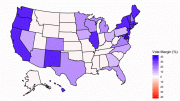
Political parties who care less about an issue will take more extreme stances on it when drawing up policies to appeal to the electorate — and it can pay off at the ballot box.
Research from Lancaster University and the University of Hagen, published in European Economic Review, shows parties can take radically different policy positions on an issue despite receiving the same information on which to base their stances. And it is those parties that have less of a stance on an issue initially which will take the more radical position when it comes to producing a platform, regardless of the information they have received.
Parties have access to information that voters do not, and when used to design their election pledges and subsequent policies, the research indicated that one will generally take an extreme stance on an issue, while the other will take a moderate policy position.
If both parties take a stand, the researchers observed that one will take a ‘pandering’ approach, presenting a platform close to what it perceives as the best policy in terms of getting votes, while the other will take a ‘anti-pandering’ stance closer to its original ideals. If just one party is sufficiently motivated to adopt a position, they will be the moderate party.
The researchers looked at the positions of political parties in Western Europe on involvement in the 2003 Iraq War, on climate change, and on nuclear power in Germany. They found that, if both parties take a stance and take the same general side on an issue, it can be the party with the more radical approach which gains the most support.
“Our research helps to explain why, even where parties are given identical signals with regards to a policy, they can diverge, with the emergence of moderate and radical parties,” said co-author Dr. Renaud Foucart, of Lancaster University Management School.
“What we found with our model was that where two parties took a stance on an issue, there would be one more moderate and one more radical, but if only one did, this would be the one with the moderate stance. This implies that it is parties who care least about policies who will make the more audacious, radical proposals on issues while those who care most will not alter their positions.
“There is the possibility that the extreme party is taking this position in an attempt to win an election, rather than because they have any prior belief in their platform, as they pander to voters.
“Our model, when we looked at both the issues of the UK entering into the Iraq War in 2003 and with approaches to nuclear power in Germany, found that the extreme policy is chosen by the electorate when the moderate party goes in the same direction.
“In the Iraq war example, the UK went to war because both main parties — Labour and the Conservatives — were to some extent conveying the message that it makes sense to do so.
“In the nuclear power example, German Chancellor Angela Merkel and her Christian Democratic Party (CDU) dramatically changed their stance following the Fukushima disaster in Japan from supporting the continuation of atomic power to a quick phase-out. She was able to close all nuclear power plants at once because her political opponents the SPD took a more moderate stance on the same side of the argument and believed nuclear electricity should be phased out gradually. ”
He added: “Even interested voters cannot be well informed about every conceivable policy. They have to rely on representatives and experts to provide information, and parties signal the information they have via their platforms — with the more attractive elected.
“Parties take the more moderate or extreme position, but our model shows that voters are able to deduce which party is conveying the more credible message.”
Reference: “(Almost) efficient information transmission in elections” by Renaud Foucart and Robert C. Schmidt, October 2019, European Economic Review.
DOI: 10.1016/j.euroecorev.2019.07.005









Whoa! Unless this article misreads the research, the conclusion is wholly unsound. The research is simply simulation using a model! The research ASSUMES that parties that end up with an extreme position started with an extreme position. The claimed support for this assumption is that flip-flopping is so politically costly, rarely are final positions the same as initial positions. That is a highly flawed statement of support, and it sounds like they didn’t test it, either. Voters might not like flip-flopping sides, but voters don’t seem to react as much against parties taking a harder/clearer stand. If anything, the voters might like that. It’s not flip-flopping, it’s clarifying or even doubling down and showing commitment to an initial stance. I call BS on this so-called research. They need physicists to do this research, not the political marketing types who make claims as they want, waving their hands and saying, “Well, it sounds consistent to me so it must be true.” Any wise person knows consistency can be found in many bad hypotheses. As long as you choose the right set of assumptions, you can make any cockamamie idea sound consistent and “therefore” true.
Add-on to my comment. I read the research abstract, not just the article. The study is unsound!